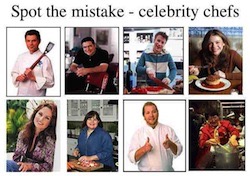ozforex
Speaking of cooking shows, researchers from Germany have concluded poor hygiene when handling food is a major cause of foodborne illness.
 To investigate whether hygiene practices visible in television cooking shows influence viewers’ kitchen hygiene, a study on the adoption of demonstrated hygiene behavior was conducted under controlled, experimental conditions. In a study ostensibly on cooking by following recipes participants (n = 65) were randomly assigned to one of three conditions, in which they watched a cooking video that differed only with regard to the hygiene behavior of the chef. In condition 1, the chef engaged in poor hygiene practices while preparing the dish, in condition 2 the chef’s hygiene behavior was exemplary and in condition 3, the chef’s hygiene behavior was not visible (control condition).
To investigate whether hygiene practices visible in television cooking shows influence viewers’ kitchen hygiene, a study on the adoption of demonstrated hygiene behavior was conducted under controlled, experimental conditions. In a study ostensibly on cooking by following recipes participants (n = 65) were randomly assigned to one of three conditions, in which they watched a cooking video that differed only with regard to the hygiene behavior of the chef. In condition 1, the chef engaged in poor hygiene practices while preparing the dish, in condition 2 the chef’s hygiene behavior was exemplary and in condition 3, the chef’s hygiene behavior was not visible (control condition).
 After watching the video, participants were instructed to cook the recipe individually in the fully equipped laboratory kitchen. (Figure, above: Illustration of how three video versions with different hygiene levels were realized, using seasoning as an example. (Panel a) Correct hygiene video: Seasoning with spoon. (Panel b) Poor hygiene video: Seasoning with fingers (after touching raw chicken). (Panel c) Control video: Close‐up of food being sprinkled with seasoning.) Cooking sessions were videotaped and experimenters blind to condition coded hygiene lapses committed by participants. The level of kitchen hygiene displayed in the cooking video significantly affected hygiene practices of participants cooking the recipe. Participants who had watched the cooking video with correct hygiene practices committed significantly fewer hygiene lapses than those who had watched the video with poor hygiene practices. From a risk communication perspective, TV cooking shows are well placed to convey knowledge of essential hygiene practices during food preparation to a broad audience. To facilitate behavioral change toward safer food‐handling practices among viewers, visibly performing correct hygiene practices in cooking shows is a promising strategy.
After watching the video, participants were instructed to cook the recipe individually in the fully equipped laboratory kitchen. (Figure, above: Illustration of how three video versions with different hygiene levels were realized, using seasoning as an example. (Panel a) Correct hygiene video: Seasoning with spoon. (Panel b) Poor hygiene video: Seasoning with fingers (after touching raw chicken). (Panel c) Control video: Close‐up of food being sprinkled with seasoning.) Cooking sessions were videotaped and experimenters blind to condition coded hygiene lapses committed by participants. The level of kitchen hygiene displayed in the cooking video significantly affected hygiene practices of participants cooking the recipe. Participants who had watched the cooking video with correct hygiene practices committed significantly fewer hygiene lapses than those who had watched the video with poor hygiene practices. From a risk communication perspective, TV cooking shows are well placed to convey knowledge of essential hygiene practices during food preparation to a broad audience. To facilitate behavioral change toward safer food‐handling practices among viewers, visibly performing correct hygiene practices in cooking shows is a promising strategy.
Kitchen hygiene in the spotlight: How cooking shows influence viewers’ hygiene practices
Risk Analysis
Severine Koch, Mark Lohmann, Jasmin Geppert, Rainer Stamminger, Astrid Epp, Gaby‐Fleur Böl
https://doi.org/10.1111/risa.13584
https://onlinelibrary.wiley.com/doi/full/10.1111/risa.13584
Research for one of our most popular paers was initiated almost 20 years ago. The abstract is below:
Mathiasen, L.A., Chapman, B.J., Lacroix, B.J. and Powell, D.A. 2004. Spot the mistake: Television cooking shows as a source of food safety information, Food Protection Trends 24(5): 328-334.
Consumers receive information on food preparation from a variety of sources. Numerous studies conducted over the past six years demonstrate that television is one of the primary sources for North Americans. This research reports on an examination and categorization of messages that television food and cooking programs provide to viewers about preparing food safely.
 During June 2002 and 2003, television food and cooking programs were recorded and reviewed, using a defined list of food safety practices based on criteria established by Food Safety Network researchers. Most surveyed programs were shown on Food Network Canada, a specialty cable channel. On average, 30 percent of the programs viewed were produced in Canada, with the remainder produced in the United States or United Kingdom.
During June 2002 and 2003, television food and cooking programs were recorded and reviewed, using a defined list of food safety practices based on criteria established by Food Safety Network researchers. Most surveyed programs were shown on Food Network Canada, a specialty cable channel. On average, 30 percent of the programs viewed were produced in Canada, with the remainder produced in the United States or United Kingdom.
Sixty hours of content analysis revealed that the programs contained a total of 916 poor food-handling incidents. When negative food handling behaviors were compared to positive food handling behaviors, it was found that for each positive food handling behavior observed, 13 negative behaviors were observed. Common food safety errors included a lack of hand washing, cross-contamination and time-temperature violations.
While television food and cooking programs are an entertainment source, there is an opportunity to improve their content so as to promote safe food handling.









